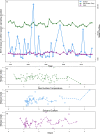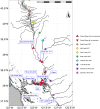Striped bass (Morone saxatilis) migration timing driven by estuary outflow and sea surface temperature in the San Francisco Bay-Delta, California
- PMID: 33452283
- PMCID: PMC7810903
- DOI: 10.1038/s41598-020-80517-5
Striped bass (Morone saxatilis) migration timing driven by estuary outflow and sea surface temperature in the San Francisco Bay-Delta, California
Abstract
The influence of climate on the timing of large-scale animal migrations is a major ecological and resource management concern. Anadromous fish migrations can have broad scale impacts on human communities and marine, aquatic and terrestrial food webs. However, isolating the effects of climate change on the timing of life stage transitions for anadromous fish species is challenging. Striped bass (Morone saxatilis) exhibit striking variation in migration patterns within their natural range, including migratory behaviors that change with latitude, and climate-induced temperature changes are predicted to drive future habitat and distribution changes. Here we explore the linkages between migration and multiple components of coastal and inland aquatic ecosystems impacted by climate change. By leveraging environmental and fisheries monitoring which began in 1969, we describe the upstream migration timing of non-native adult Striped bass influenced by estuary outflow and sea surface temperature in the San Francisco Bay-Delta, California. Striped bass migrated later in years when Delta outflow was greater and sea surface temperature was cooler. It is likely that temperature thresholds in the ocean during the springtime provide a cue for Striped bass to initiate migration, but sea surface temperature may also represent composite climatic trends influencing Striped bass. Further, the observed variation in migration timing of adult Striped bass has implications for predation risk on the seaward-migration of juvenile Chinook salmon.
Conflict of interest statement
The authors declare no competing interests.
Figures




Similar articles
-
Differential migration in Chesapeake Bay striped bass.PLoS One. 2020 May 14;15(5):e0233103. doi: 10.1371/journal.pone.0233103. eCollection 2020. PLoS One. 2020. PMID: 32407398 Free PMC article.
-
Multiple spawning run contingents and population consequences in migratory striped bass Morone saxatilis.PLoS One. 2020 Nov 25;15(11):e0242797. doi: 10.1371/journal.pone.0242797. eCollection 2020. PLoS One. 2020. PMID: 33237952 Free PMC article.
-
Comparative migration ecology of striped bass and Atlantic sturgeon in the US Southern mid-Atlantic bight flyway.PLoS One. 2020 Jun 17;15(6):e0234442. doi: 10.1371/journal.pone.0234442. eCollection 2020. PLoS One. 2020. PMID: 32555585 Free PMC article.
-
Chemical contamination and the annual summer die-off of striped bass (Morone saxatilis) in the Sacramento-San Joaquin Delta.Chem Res Toxicol. 1992 Jan-Feb;5(1):100-5. doi: 10.1021/tx00025a017. Chem Res Toxicol. 1992. PMID: 1581525
-
Long-term effect of a tidal, hydroelectric propeller turbine on the populations of three anadromous fish species.J Fish Biol. 2018 Aug;93(2):192-206. doi: 10.1111/jfb.13755. J Fish Biol. 2018. PMID: 30043424 Review.
Cited by
-
Long-term data reveal widespread phenological change across major US estuarine food webs.Ecol Lett. 2024 Dec;27(12):e14441. doi: 10.1111/ele.14441. Ecol Lett. 2024. PMID: 39738977 Free PMC article.
-
Four decades of climatic fluctuations and fish recruitment stability across a marine-freshwater gradient.Glob Chang Biol. 2022 Sep;28(17):5104-5120. doi: 10.1111/gcb.16266. Epub 2022 Jun 16. Glob Chang Biol. 2022. PMID: 35583053 Free PMC article.
-
Coldwater fish in a warm water world: Implications for predation of salmon smolts during estuary transit.Ecol Evol. 2021 Jun 28;11(15):10381-10395. doi: 10.1002/ece3.7840. eCollection 2021 Aug. Ecol Evol. 2021. PMID: 34367582 Free PMC article.
References
-
- Lucas MC, Baras E. Migration of Freshwater Fishes. Oxford: Wiley-Blackwell; 2001.
Publication types
MeSH terms
LinkOut - more resources
Full Text Sources
Other Literature Sources

